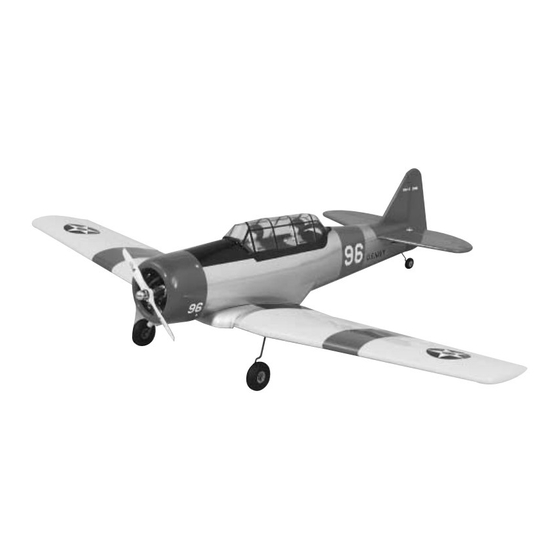GREAT PLANES AT-6 Texan Manual de instruções - Página 19
Procurar online ou descarregar pdf Manual de instruções para Brinquedo GREAT PLANES AT-6 Texan. GREAT PLANES AT-6 Texan 20 páginas. Legendary warbirds custom-wood series

FLYING
The Great Planes AT-6 ARF is a great-flying plane that flies
smoothly and predictably. The AT-6 does not, however,
possess the self-recovery characteristics of a primary R/C
trainer and should only be flown by experienced RC pilots.
Caution: (THIS APPLIES TO ALL R/C AIRPLANES): If,
while flying, you notice any unusual sounds, such as a
low-pitched "buzz," this may indicate control surface
"flutter." Because flutter can quickly destroy components
or your airplane, any time you detect flutter you must
immediately cut the throttle and land the airplane! Check
all servo grommets for deterioration (this may indicate
which surface fluttered) and make sure all pushrod
linkages are slop-free. If it fluttered once, it will probably
flutter again under similar circumstances unless you can
eliminate the slop or flexing in the linkages. Here are
some things which can result in flutter: Excessive hinge
gap; Not mounting control horns solidly; Sloppy fit of
clevis pin in horn; elasticity present in flexible plastic
pushrods; Side-play of pushrod in guide tube caused by
tight bends; Sloppy fit of control rods in servo horns;
Insufficient glue used when gluing in torque rods;
Excessive flexing of aileron, caused by using too soft
balsa; Excessive "play" or "backlash" in servo gears; and
insecure servo mounting.
Takeoff
Take off on low rates if you have dual rates on your
transmitter - especially if you are taking off into a crosswind.
For all models it is good practice to gain as much speed as
the length of the runway will permit before lifting off. This
will give you a safety margin in case the engine quits. When
the plane has gained enough flying speed to safely lift off,
gradually and smoothly apply up elevator and allow the
model to climb at a shallow angle (do not yank the model
off the ground into a steep climb!)
Flight
We recommend that you take it easy with your AT-6 for the
first several flights, gradually "getting acquainted" with this
great model as your engine gets fully broken-in. If you feel as
though you have your hands full, keep this in mind: pull back
on the throttle stick to slow the model down. This will make
everything happen a little slower and allow yourself time to
think and react. Add and practice one maneuver at a time,
learning how the AT-6 behaves in each. For smooth flying
and normal maneuvers, use the low rate settings as listed on
page 14. Use the high rate settings for hot dogging.
Sometime well before it's time to land, you should climb
your AT-6 to a safe altitude, cut the throttle to an idle and
check out the model's low speed characteristics. Do this a
few times so you know what to expect upon landing and
how the AT-6 handles stalls.
Landing
When it's time to land, fly a normal landing pattern and
approach. Keep a few clicks of power on until you are over
the runway threshold. For your first few landings, plan to
land slightly faster than stall speed.
Have a ball! But always remember to think about your next
move and plan each maneuver before you do it. Impulsively
"jamming the sticks" without any thought is what gets most
fliers in trouble rather than lack of flying skill.
Happy Landings!
ENGINE MOUNT TEMPLATE
19
